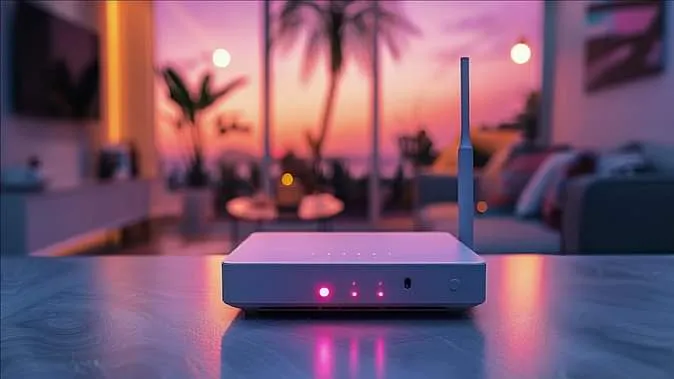In today’s digital age, fast internet has become a need of everyone. It is difficult to imagine the Internet without home or office, Wi-Fi router. However, ignoring Wi-Fi’s security can prove dangerous.
If your Wi-Fi is not safe, then you may face problems like slow internet, cyber attack and hacking. Many times people connect with your network without permission reduce your internet speed or try to steal your personal information.
Therefore, it is very important to adopt some important measures to protect Wi-Fi. Let’s know easy and effective tips to strengthen Wi-Fi security.

1. Create Strong Password
 Creating a strong and unique password for Wi-Fi is the first and most important thing.
Creating a strong and unique password for Wi-Fi is the first and most important thing.
 The password should be at least 12-16 characters.
The password should be at least 12-16 characters.
 It should have a mixture of alphabet (AZ, AZ), number (0-9) and special characters (!, @, #, $ Etc.).
It should have a mixture of alphabet (AZ, AZ), number (0-9) and special characters (!, @, #, $ Etc.).
 Avoid using easy passwords such as “12345”, “Password”, “Admin” or your name.
Avoid using easy passwords such as “12345”, “Password”, “Admin” or your name.
 If you have trouble remembering the password, use the password manager.
If you have trouble remembering the password, use the password manager.
2. Change Default username and password
 Every Wi-Fi router is given a default username and password, which is necessary to change.
Every Wi-Fi router is given a default username and password, which is necessary to change.
 Hackers can easily break these default credentials, allowing them to access your network.
Hackers can easily break these default credentials, allowing them to access your network.
 Go to the router settings and immediately change the default username and password.
Go to the router settings and immediately change the default username and password.
how to change?
- Open the web browser and enter the IP address (192.168.1.1 or 192.168.0.1).
- Login by adding username and password.
- Go to Settings and set a new username and strong password.
3. Use WPA3 or WPA2 encryption
 Enable WPA3 or WPA2 encryption to increase the safety of Wi-Fi network.
Enable WPA3 or WPA2 encryption to increase the safety of Wi-Fi network.
 WPA3 (Wi-Fi Protected Access 3) is the safest encryption protocol, which protects the network from unauthorized access.
WPA3 (Wi-Fi Protected Access 3) is the safest encryption protocol, which protects the network from unauthorized access.
 If WPA3 is not available, select WPA2-PSK (AES).
If WPA3 is not available, select WPA2-PSK (AES).
 Do not use old Wep (wired Equivalent Privacy) encryption, as it is weak and unsafe.
Do not use old Wep (wired Equivalent Privacy) encryption, as it is weak and unsafe.
how to change?
- Go to the router settings.
- Open the wireless security option.
- Choose and save WPA3 or WPA2.
4. Use guest network
 If people in your home or office come to use Wi-Fi again and again, create a separate guest network for them.
If people in your home or office come to use Wi-Fi again and again, create a separate guest network for them.
 This will keep your main network safe and unknown people will not get access to your main network.
This will keep your main network safe and unknown people will not get access to your main network.
 Set separate passwords for the guest network and keep changing it from time to time.
Set separate passwords for the guest network and keep changing it from time to time.
How to set?
- Go to the router settings.
- Turn on the “Guest Network” option.
- For this, set a separate password.
5. MAC address filtering on
 With the help of MAC address filtering, you can decide that only selected devices can connect to your Wi-Fi.
With the help of MAC address filtering, you can decide that only selected devices can connect to your Wi-Fi.
 With this, no new unknown device will be able to connect to Wi-Fi without your permission.
With this, no new unknown device will be able to connect to Wi-Fi without your permission.
How to do?
- Login in router settings.
- Go to the Mac Filtering Option.
- Only add and save the MAC address of your device.
Tip: Go to the Wi-Fi settings of your phone or laptop to see the MAC address.
6. Change password from time to time
 Wi-Fi password should be changed every 3-6 months.
Wi-Fi password should be changed every 3-6 months.
 If you have not changed your password for a long time, update it immediately.
If you have not changed your password for a long time, update it immediately.
 If you had given a password to an outsider, it becomes even more important to change it.
If you had given a password to an outsider, it becomes even more important to change it.
how to change?
- Go to the router settings.
- Go to wireless settings and enter a new password.
- Connect all the devices to the new password.
7. Keep updating firmware
 It is necessary to keep updating the firmware of the router from time to time.
It is necessary to keep updating the firmware of the router from time to time.
 The new updates have security patches, which help protect against hacking and cyber attachments.
The new updates have security patches, which help protect against hacking and cyber attachments.
How to do?
- Login in router settings.
- Click on “Firmware Update” option.
- If any update is available, download and install it.
8. Close Auto-Connect and WPS feature
 Many times an auto-connect feature is turned on in your phone or laptop, so that you can connect with any Wi-Fi network without thinking.
Many times an auto-connect feature is turned on in your phone or laptop, so that you can connect with any Wi-Fi network without thinking.
 Turn off the WPS (Wi-Fi Protected Setup) feature, as this is an easy way for hackers to make a dent in the network.
Turn off the WPS (Wi-Fi Protected Setup) feature, as this is an easy way for hackers to make a dent in the network.
How to do?
- Go to the router settings.
- Disable the “WPS Settings” option.
